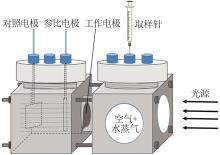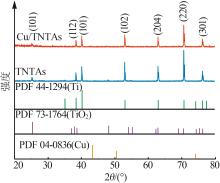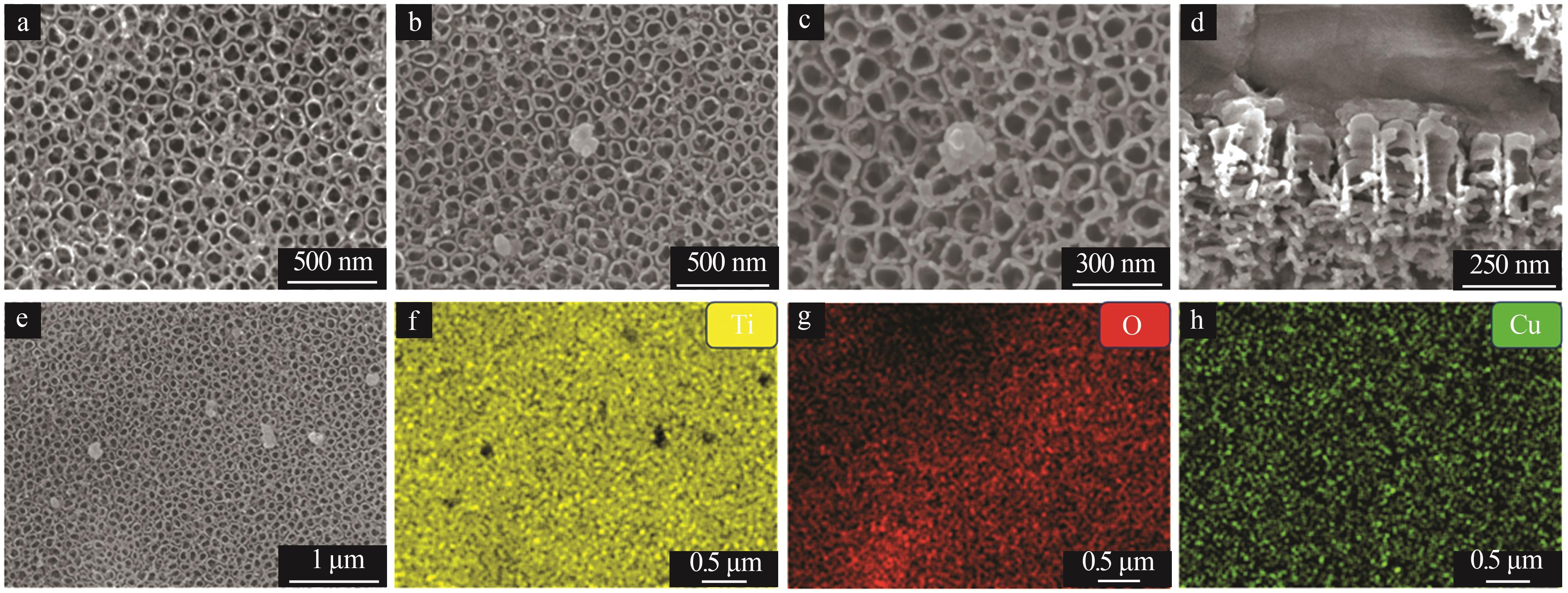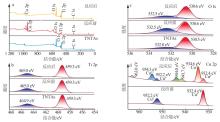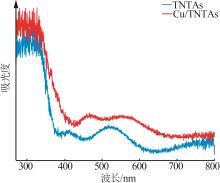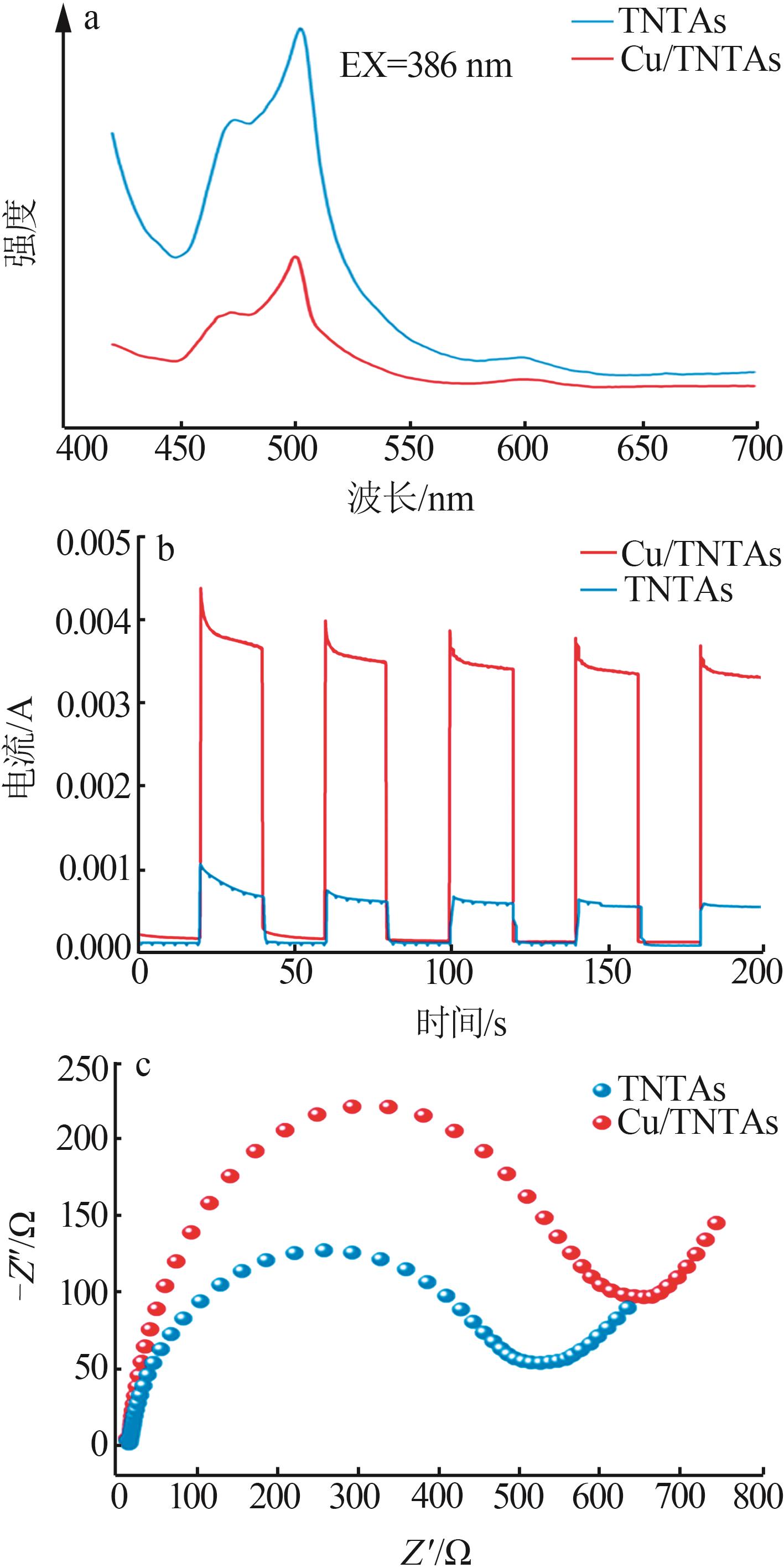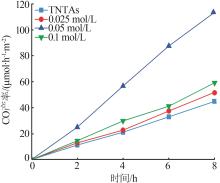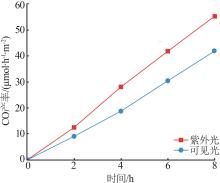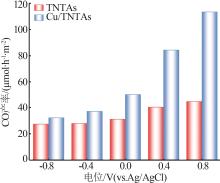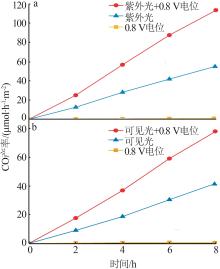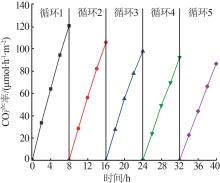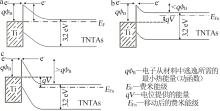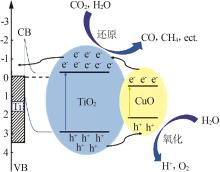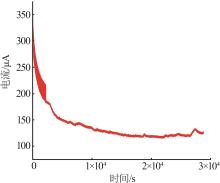Inorganic Chemicals Industry ›› 2024, Vol. 56 ›› Issue (9): 154-163.doi: 10.19964/j.issn.1006-4990.2023-0627
• Catalytic Materials • Previous Articles Next Articles
Study on electro-assisted photocatalytic high selective conversion of CO2 in air
SHI Mengke( ), FAN Zhaoya, YUE Feng, ZHANG Shuo, MENG Yang, ZHANG Hongzhong(
), FAN Zhaoya, YUE Feng, ZHANG Shuo, MENG Yang, ZHANG Hongzhong( )
)
- College of Materials and Chemical Engineering,Zhengzhou University of Light Industry,Henan Collaborative Innovation Center for Environmental Pollution Control and Ecological Restoration,Zhengzhou 450001,China
-
Received:2023-12-30Online:2024-09-10Published:2024-02-18 -
Contact:ZHANG Hongzhong E-mail:1102730264@qq.com;zhz@zzuli.edu.cn
CLC Number:
Cite this article
SHI Mengke, FAN Zhaoya, YUE Feng, ZHANG Shuo, MENG Yang, ZHANG Hongzhong. Study on electro-assisted photocatalytic high selective conversion of CO2 in air[J]. Inorganic Chemicals Industry, 2024, 56(9): 154-163.
share this article
| 1 | MURINGA KANDY M, RAJEEV K A, SANKARALINGAM M.Development of proficient photocatalytic systems for enhanced photocatalytic reduction of carbon dioxide[J].Sustainable Ener- gy & Fuels,2021,5(1):12-33. |
| 2 | GONG E,ALI S, HIRAGOND C B,et al.Solar fuels:Research and development strategies to accelerate photocatalytic CO2 conversion into hydrocarbon fuels[J].Energy & Environmental Science,2022,15(3):880-937. |
| 3 | 郭天宇,张佳宁,白德豪 等.氮掺杂生物质炭耦合氧化铜材料用于电催化还原CO2 [J/OL].太原理工大学学报,2024:1-10[2024-02-07].http://kns.cnki.net/kcms/detail/14.1220.N.20240202.1714.003.html. |
| GUO Tianyu, ZHANG Jianing, BAI Dehaoet al.Nitrogen-doped biomass carbon coupled with copper oxide materials for electrocatalytic reduction of CO2 [J/OL].Journal of Taiyuan University of Technology:2024:1-10[2024-02-07].http://kns.cnki.net/kcms/detail/14.1220.N.20240202.1714.003.html. | |
| 4 | 赵炎,郝雪薇,时海南,等.铜掺杂TiO2/PCN异质结光催化还原二氧化碳性能研究[J].无机盐工业,2023,55(8):21-27. |
| ZHAO Yan, HAO Xuewei, SHI Hainan,et al.Study on photocatalytic CO2 reduction performance of Cu-doped TiO2/PCN heterojunction[J].Inorganic Chemicals Industry,2023,55(8):21-27. | |
| 5 | BAI Yujie, ZHAO Jie, FENG Shuaijun,et al.Light-driven thermocatalytic CO2 reduction over surface-passivated β-Mo2C nanowires:Enhanced catalytic stability by light[J].Chemical Communications,2019,55(32):4651-4654. |
| 6 | HABISREUTINGER S N, SCHMIDT-MENDE L, STOLARCZYK J K.Photocatalytic reduction of CO2 on TiO2 and other semiconductors[J].Angewandte Chemie International Edition,2013,52(29):7372-7408. |
| 7 | INDRAKANTI V P, KUBICKI J D, SCHOBERT H H.Photoinduced activation of CO2 on Ti-based heterogeneous catalysts:Current state,chemical physics-based insights and outlook[J].Ener- gy & Environmental Science,2009,2(7):745-758. |
| 8 | ETTEDGUI J, DISKIN-POSNER Y, WEINER L,et al.Photoreduction of carbon dioxide to carbon monoxide with hydrogen catalyzed by a rhenium(I) phenanthroline-polyoxometalate hybrid complex[J].Journal of the American Chemical Society,2011,133(2):188-190. |
| 9 | 赵馨,邹伟欣,董林.高分散铈物种催化剂的可控制备及其光催化还原CO2为CH4的促进机制[J/OL].环境化学,2024,43:1-9.[2024-02-07]http://kns.cnki.net/kcms/detail/11.1844.X.20240202.1512.050.html. |
| ZHAO Xin, ZOU Weixin, DONG Lin.Highly dispersed Ce species on g-C3N4 for the enhanced selectivity of photocatalytic CO2 reduction to CH4[J/OL].Environmental Chemistry,2024,43:1-9.[2024-02-07]http://kns.cnki.net/kcms/detail/11.1844.X.20240202.1512.050.html. | |
| 10 | 宋桂贤,吴雄岗.不同形貌的CdS/BiOBr复合物对环己醇中光催化还原CO2活性的影响[J].工业催化,2023,31(11):61-66. |
| SONG Guixian, WU Xionggang.Performance of CdS/BiOBr composites with different morphology in photocatalytic reduction of CO2 in cyclohexanol[J].Industrial Catalysis,2023,31(11):61- 66. | |
| 11 | 郑国宏,张春雷,陈旻澍,等.CoP/g-C3N4复合材料的制备及其光催化还原CO2性能[J].化工环保,2023,43(6):821-828. |
| ZHENG Guohong, ZHANG Chunlei, CHEN Minshu,et al.Preparation of CoP/g-C3N4 composite and its activity for photocatalytic reduction of CO2 [J].Environmental Protection of Chemical Industry,2023,43(6):821-828. | |
| 12 | 方伟,孙志敏,赵雷,等.三维g-C3N4泡沫负载Cu(OH)2纳米片的制备及其光催化还原CO2性能[J].材料工程,2023,51(4):141-150. |
| FANG Wei, SUN Zhimin, ZHAO Lei,et al.Preparation of 3D g-C3N4 foam supported Cu(OH)2 nanosheets for photocatalytic CO2 reduction[J].Journal of Materials Engineering,2023,51(4):141-150. | |
| 13 | PARK J H, KIM S, BARD A J.Novel carbon-doped TiO2 nanotube arrays with high aspect ratios for efficient solar water splitting[J].Nano Letters,2006,6(1):24-28. |
| 14 | 黎文辉,黄建光,陈彩霞.贵金属负载型TiO2光催化法处理含酚工业废水研究[J].化学工程师,2024,38(2):34-37. |
| LI Wenhui, HUANG Jianguang, CHEN Caixia.Treatment of phenol containing industrial wastewater by noble metal supported TiO2 photocatalysis[J].Chemical Engineer,2024,38(2):34-37. | |
| 15 | 石支尧,李扬,徐静文,等.铜铈共掺杂TiO2用于天然气中汞的光催化脱除研究[J].现代化工,2023,43(4):81-86,92. |
| SHI Zhiyao, LI Yang, XU Jingwen,et al.Copper-cerium Co-do-ped TiO2 for photocatalytic removal of mercury from natural gas[J].Modern Chemical Industry,2023,43(4):81-86,92. | |
| 16 | AMORÓS-PÉREZ A, CANO-CASANOVA L,LILLO-RÓDENAS |
| M Á,et al.Cu/TiO2 photocatalysts for the conversion of acetic acid into biogas and hydrogen[J].Catalysis Today,2017,287:78-84. | |
| 17 | 柳准,徐启杰,张莉莉,等.TiO2/Cu复合材料的光催化降解和抗菌性能研究及机理分析[J].化工新型材料,2023,51(9):209-212,219. |
| LIU Zhun, XU Qijie, ZHANG Lili,et al.Studies on the photocatalytic degradation and antimicrobial properties of TiO2/Cu composite as well as the mechanism[J].New Chemical Materials,2023,51(9):209-212,219. | |
| 18 | CHEN Boren, NGUYEN V H, WU J C S,et al.Production of renewable fuels by the photohydrogenation of CO2:Effect of the Cu species loaded onto TiO2 photocatalysts[J].Physical Chemistry Chemical Physics:PCCP,2016,18(6):4942-4951. |
| 19 | 夏建强,丁立勤,张海明,等.Cu-TiO2催化剂模拟太阳光光催化降解环丙沙星[J].广东化工,2023,50(13):139-141, 144. |
| XIA Jianqiang, DING Liqin, ZHANG Haiming,et al.Photocatalytic degradation of ciprofloxacin by simulating sunlight with Cu-doped TiO2 catalysts[J].Guangdong Chemical Industry,2023,50(13):139-141,144. | |
| 20 | 蒋毅.聚多巴胺功能修饰及原位化学还原法制备纳米Ag复合材料[D].北京:北京化工大学,2012. |
| JIANG Yi.Preparation of nano Ag composites by poly(dopamine) functionalization and in situ chemical reduction[D].Beijing:Beijing University of Chemical Technology,2012. | |
| 21 | FRONCISZ W, SARNA T, HYDE J S.Cu2+ probe of metal-ion binding sites in melanin using electron paramagnetic resonance spectroscopy.I.Synthetic melanins[J].Archives of Biochemistry and Biophysics,1980,202(1):289-303. |
| 22 | AN Peng, ZUO Fang, LI Xinhua,et al.A bio-inspired polydopamine approach to preparation of gold-coated Fe3O4 core-shell nanoparticles:Synthesis,characterization and mechanism[J].Nano,2013,8(6):1350061. |
| 23 | CONG Ying, XIA Tian, ZOU Miao,et al.Mussel-inspired polydopamine coating as a versatile platform for synthesizing polystyrene/Ag nanocomposite particles with enhanced antibacterial activities[J].Journal of Materials Chemistry B,2014,2(22):3450-3461. |
| 24 | HU A, LIANG R, ZHANG X,et al.Enhanced photocatalytic degradation of dyes by TiO2 nanobelts with hierarchical structur-es[J].Journal of Photochemistry and Photobiology A:Chemistry,2013,256:7-15. |
| 25 | WANG Lan, ZHOU Hanghang, ZHANG Hongzhong,et al.SiO2@TiO2 Core@Shell nanoparticles deposited on 2D-layered ZnIn2S4 to form a ternary heterostructure for simultaneous photocatalytic hydrogen production and organic pollutant degradati- on[J].Inorganic Chemistry,2020,59(4):2278-2287. |
| 26 | PAULINO P N, SALIM V M M, RESENDE N S.Zn-Cu promoted TiO2 photocatalyst for CO2 reduction with H2O under UV light[J].Applied Catalysis B:Environmental,2016,185:362-370. |
| 27 | CHEN Changzhou, LIU Peng, XIA Haihong,et al.Photocatalytic cleavage of β-O-4 ether bonds in lignin over Ni/TiO2 [J].Molecules,2020,25(9):2109. |
| 28 | REN Haitao, HAN Jing, LI Tingting,et al.Visible light-induced oxidation of aqueous arsenite using facile Ag2O/TiO2 composites:Performance and mechanism[J].Journal of Photochemistry and Photobiology A:Chemistry,2019,377:260-267. |
| 29 | SALEH R, TAUFIK A, PRAKOSO S P.Fabrication of Ag2O/TiO2 composites on nanographene platelets for the removal of organic pollutants:Influence of oxidants and inorganic anions[J].Applied Surface Science,2019,480:697-708. |
| 30 | ZHAO Jie, LI Yingxuan, ZHU Yunqing,et al.Enhanced CO2 photoreduction activity of black TiO2-coated Cu nanoparticles under visible light irradiation:Role of metallic Cu[J].Applied Catalysis A:General,2016,510:34-41. |
| 31 | ZHANG Minghui, WANG Xiao, QI Xiwei,et al.Effect of Ag cocatalyst on highly selective photocatalytic CO2 reduction to HCOOH over CuO/Ag/UiO-66 Z-scheme heterojunction[J].Jo- urnal of Catalysis,2022,413:31-47. |
| 32 | LIU Fuli, SONG Lizhu, OUYANG Shuxin,et al.Cu-Based mixed metal oxides for an efficient photothermal catalysis of the water-gas shift reaction[J].Catalysis Science & Technology,2019,9(9):2125-2131. |
| 33 | CHEN Lin, LI Hongyi, LI Hongmei,et al.Accelerating photogenerated charge kinetics via the g-C3N4 Schottky junction for enhanced visible-light-driven CO2 reduction[J].Applied Catalysis B:Environmental,2022,318:121863. |
| [1] | XU Jing, WANG Dahui, CHEN Huaijing, GUO Yongqi, ZHENG Yang. Research progress on regeneration utilization of LiFePO4 materials in retired power batteries of electric vehicles [J]. Inorganic Chemicals Industry, 2024, 56(8): 1-8. |
| [2] | LIU Hui, WANG Hongliang, YU Kun, GAO Shengnan. Effect of calcination on porous structure and electrochemical properties of air electrode [J]. Inorganic Chemicals Industry, 2024, 56(6): 80-86. |
| [3] | WANG Zhiqiang, LIU Xiangcheng, ZHANG Junjie, JIN Wufeng. Study on kinetic model of low concentration formaldehyde catalyzed by copper-manganese oxide [J]. Inorganic Chemicals Industry, 2023, 55(6): 142-150. |
| [4] | XUE Haiyue,WANG Lianyong,LIU Xiangyu,HAN Jianli,YANG Yifan. Analysis and prospect of using fly ash based zeolite for infrared suppression of tail flame of aircraft [J]. Inorganic Chemicals Industry, 2022, 54(3): 23-30. |
| [5] | SHEN Jiaqi,YAN Shenghu,ZHANG Yue,LIU Jianwu,SHEN Jiefa. Study on intensification of gas-liquid reaction process for sodium chloride waste salt to ammonium alkali [J]. Inorganic Chemicals Industry, 2022, 54(12): 99-105. |
| [6] | Wang Xiangjun,Gao Li,Xu Lei,Chi Yongqing. Study on CoFe2O4@C as cathode catalyst of Li-air battery [J]. Inorganic Chemicals Industry, 2021, 53(5): 96-99. |
| [7] | Zhang Wenxian,Liu Liansheng,Cao Hejun,Wu Binke,Cheng Zhenpeng. Effect on kinetics of limestone decomposition under different CO2 atmospheres [J]. Inorganic Chemicals Industry, 2020, 52(3): 59-63. |
| [8] | Hang Meiyan,Peng Yajuan,Lu Lan,Zhang Haiyan,Tao Xu. Modification study and mechanism analysis on interface structure between ferrochromium slag aggregate and cement paste [J]. Inorganic Chemicals Industry, 2020, 52(12): 75-79. |
| [9] | Yuan Yawei,Li Yong. Research progress of ZSM-5 molecular sieve adsorbents used in pollution control [J]. Inorganic Chemicals Industry, 2019, 51(10): 18-21. |
| [10] | ZHAO Yun, YANG Xu, DAN Jian-Ming, QIAO Xiu-Wen, LI Hong-Ling, HONG Cheng-Lin. Study on preparation of silica nanoparticles by silicon tetrachloride with air blowing method [J]. INORGANICCHEMICALSINDUSTRY, 2014, 46(8): 28-. |
| [11] | TAN Xiu-Min, ZHANG Xiu-Feng, ZHANG Li-Zhen. Study on bromine extraction technology of Jiangling depression deep brine [J]. INORGANICCHEMICALSINDUSTRY, 2013, 45(5): 13-. |
| [12] | Xing Shujian;Zang Jiazhong;Liu Wei;Liu Guanfeng;Sun Chunhui;Yu Haibin. Progress on industrial application of molecular sieve adsorbents [J]. INORGANICCHEMICALSINDUSTRY, 2009, 0(3): 0-0. |
| [13] | Liu Xianglai. Improvement of utilization rate of air in hydrogen peroxide unit [J]. INORGANICCHEMICALSINDUSTRY, 2009, 0(1): 0-0. |
| [14] | Ye Yiyin. On domestic and international sodium chlorate manufacturing and equipment technology [J]. INORGANICCHEMICALSINDUSTRY, 2008, 0(2): 0-0. |
| Viewed | ||||||
|
Full text |
|
|||||
|
Abstract |
|
|||||
|
||
